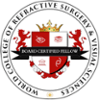Wavefront Aberrometry
What is it?
Wavefront aberrometry is used to measure the optical imperfections of the eye that cannot be corrected with glasses alone. These are known as the higher-order aberrations in your visual system.
These irregularities may affect your cornea and optical system and impact aspects of your vision beyond the normal refractive errors (myopia, hyperopia, presbyopia, and astigmatism).
How Does it Work?
A Wavefront Aberrometer measures the refractive power of your eye by recording data from light passing through your eye’s optical system (the lens and cornea). This is compared with the reference wavefront to create a map of the imperfections in your eye, as well as a visual system analysis.
Different standards of aborrometers measure different resolutions, with the number of measurement points (spots) varying from 60 to as high as 1200. The latest wavefront aberrometry device uses a different measurement system, producing images with a resolution of 40,000 points.
To put this into context, a low-resolution aberrometer can be compared with a watercolour painting; it provides a general view of the landscape measuring just a few points. A mathematical formula can be used to provide an approximate image of the rest.
In contrast, a higher resolution aberrometer provides much more detail – like a photograph. This gives a much more precise map of the number and location of any imperfections, allowing your surgeon to more accurately account for these irregularities in your treatment.
During a wavefront aberrometry, you will place your chin on a padded support and stare straight into the examining instrument. The instrument will be aligned by your optometrist and you will be asked to open your eyes wide. The ‘wavefront’ readings can then be taken from each eye.
What are the Benefits?
As mentioned above, wavefront aberrometry allows for more accurate mapping of the eye’s irregularities and imperfections. This data can then be fed into the laser to achieve better results during your Laser Eye Surgery procedure.
Performing a wavefront aberrometry helps your surgeon to determine whether you could benefit from ‘wavefront-guide’ Laser Eye Surgery treatment. This technique aims to improve the optical imperfections that cannot be corrected by glasses alone.
Finally, wavefront technology can also be used to detect certain eye conditions that could prevent you from achieving optimal results with Laser Eye Surgery.
What will I feel?
Wavefront aberrometry does not require the instrument to make direct contact with your eye. Therefore, you won’t feel anything during this step of the screening process.


